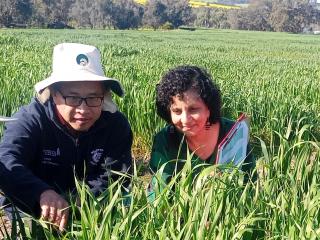Research aims to boost oat resistance against Septoria blotch in Western Australia
Project name
Mapping of Septoria isolates and oat genetic response to improve genetic solutions to Septoria management in oats in WA
Understanding Septoria blotch
Septoria blotch caused by Parastagonospora avenae (P. avenae) is a significant oat disease especially in Western Australia (WA) where almost all oat crops have some level of Septoria infection.
It can cause oat yields to drop by around 15 per cent, causing significant financial loss for farmers, especially in high rainfall areas.
The Septoria pathogen population is diverse, making breeding for durable resistance difficult.
To date, little work has been undertaken to identify and characterise genetic sources of resistance to Septoria.
With help from the Processed Oat Industry Growth Partnership, the Department of Primary Industries and Regional Development (DPIRD) is aiming to investigate variation in virulence of P. avenae isolates across regional sites of WA in response to key breeding lines and commercial varieties.
As well as to identify novel sources of Septoria blotch resistance and provide breeders with resistant germplasm and selection tools to breed varieties with durable resistance.
Unlocking the enemy
It’s hoped by 2025, researchers will have a better grasp of Septoria blotch in WA, studying how it varies in different oat-growing areas and in response to various oat types.
Oat breeders will get access to new sources and tools for Septoria blotch resistance.
This will help them create oat varieties that match specific environments and resist the disease.
By 2035, it’s hoped WA growers to have oats with increased resistance to Septoria blotch.
These oats will be tailored for different oat production regions, minimising the damage caused by the disease.
Pathway to the WA oat industry
WA oat breeders will stand to benefit immediately from the project outputs, leveraging them to develop new commercial oat varieties fortified with enhanced resistance against Septoria.
The aligned products cater to breeder needs, ensuring high adoption and utilisation probability, thereby aiding in the creation of oat varieties with heightened Septoria resistance for specific cropping environments.
The key products include:
Pathogen Virulence: Furnishing information on the variation in virulence of P. avenae isolates across diverse sites in regional Western Australia, in response to essential breeding lines and commercial varieties.
Germplasm: Providing germplasm from both national and international sources with novel Septoria blotch resistance, facilitating the development of pre-breeding and breeding strategies for the simultaneous integration of resistance in inbred lines and cultivar development.
New resistant sources will be distributed to oat breeders over the project's 3-year duration.
Screening Methods: Developing rapid, efficient, and cost-effective field and controlled environment disease screening techniques.
These techniques will employ the most recent fungal isolates to evaluate the expression of resistance in breeding lines within relevant environments.
Genetic Resources: The mapping of QTL/genes and understanding gene-environment interactions will enhance comprehension of the genetic architecture of disease resistance.
Genes and QTL discovered may be valuable in genomic selection for resistance.
In addition, the sequence and structural information of oat resistance genes will aid in understanding gene function and support the deployment of resistance genes in oat breeding programs.
As part of the project, a selection of 500 oat accessions will be made based on their response to Septoria blotch at both the seedling and adult plant stages in field sites at Manjimup and Dale.
This aims to identify germplasm with consistent Septoria blotch resistance across various growth stages, environments, and years, potentially serving as resistance donor parents in germplasm development and breeding.
Additionally, the project seeks to establish a panel of oat accessions, showcasing diversity in Septoria blotch resistance expression for genomic modelling and new QTL discovery.
This genomic work will be conducted on a platform directly linked to or the same as that used by the breeding program, ensuring a seamless translation of research outcomes to the market.
Funding partners/project collaborators
Processed Oat Partnership (POP)
InterGrain’s Oat Breeding Program
Western Crop Genetic Alliance
Contact
Manisha Shankar
DPIRD Principal Research Scientist
E: Manisha.Shankar@dpird.wa.gov.au
P: (08) 9368 3533


